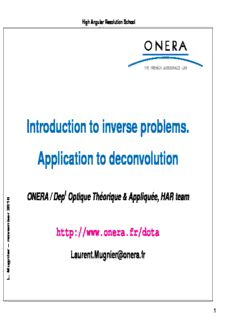
High Angular Resolution School PDF
Preview High Angular Resolution School
High Angular Resolution School THE FRENCH AEROSPACE LAB Introduction to inverse problems. Application to deconvolution t ONERA / Dep Optique Théorique & Appliquée, HAR team 0 1 0 2 r e b m http://www.onera.fr/dota e v o n – r [email protected] e i n g u M . L 1 High Angular Resolution School Context o Aim of this talk: introduction to methods for solving “inverse problems”, including image deconvolution; o Common framework for problems and methods in a wide variety of fields: + X-ray tomography; + ultrasound echography (medical diagnosis, Non-Destructive Testing); + computer vision (stereo, etc.); + geophysics; 0 1 0 2 + r wavefront sensing (Hartmann-Shack, curvature, phase diversity); e b m + e image restoration, e.g., for imaging through turbulence (w/ or without AO); v o n + – image reconstruction in interferometry, r e i n + g etc. u M . L THE FRENCH AEROSPACE LAB 2 High Angular Resolution School Inverse problem: a contrario definition o Wavefront sensing by Shack-Hartmann Unknowns: wavefront (phase) Measurements: local slopes Lenslet array Sensor 0 o 1 image restoration 0 2 r e object → atmosphere+telescope+camera → image b m e v o o n image reconstruction in long baseline optical interferometry – r e ni object → atmosphere+interferometer → visibilities g u M L. Physics → model the data, i.e., compute the direct problem. THE FRENCH AEROSPACE LAB 3 High Angular Resolution School Considered “direct model”, i.e. model of the data o linear model: y = Hx + n, H linear operator (matrix in finite dimension), y , vector of measurements (image pixels, S-H slopes,...), x , vector of unknowns (object, wavefront, etc.), n measurement noise. o convolution case: 0 1 20 + H linear and shift-invariant ⇔ Hx = h ⋆ x r e b + m h : point spread function (PSF) : x = δ ⇒ h ⋆ x = h. e v no + h˜ = FT(h) : transfer function. – r + ˜ ie Direct model: y = h ⋆ x + n where y˜ = h.x˜ + n˜ n g u M . L THE FRENCH AEROSPACE LAB 4 High Angular Resolution School “Classical” resolution of an inverse problem o One searches for xˆ ; y = Hxˆ existence o Invertible (linear) problem ∀y: ( uniqueness o If dim(x) > dim(y), not enough measurements for a unique solution. o 0 If dim(x) < dim(y), usually no solution: noise makes it impossible to fit all 1 0 2 r data. e b m e o v existence and uniqueness ∀y ⇔ H square and invertible o n – er o i Not often the case + accomodating more data is desirable! n g u M . L THE FRENCH AEROSPACE LAB 5 High Angular Resolution School Least Squares method One searches for xˆ that minimizes the Least Squares criterion: 2 2 ky − Hxˆk = inf ky − Hxk (1) x Legendre (1805) and Gauss (between 1795 and 1809) → (estimation of the Earth’s ellipticity from arc measurements definition of the meter) o existence guaranteed (in finite dimension): (1) ⇔ Py = Hxˆ, where P projector on Im(H). o uniqueness guaranteed: ⊥ if N(H) 6= {0} one projects xˆ onto N(H) → LS solution of minimal norm xˆ , or Generalized Inverse. min 0 norm 1 20 o analytical solution: xˆ = (HtH)−1Hty (generally) r e b m e v x y o T N(H) n – r H Im H nie x^min x^ g norm Py u M H N(H) . L THE FRENCH AEROSPACE LAB 6 High Angular Resolution School Hartmann-Shack Wave Front Sensor incident wavefront Sub−images Microlens array (cid:0)(cid:1) Sensor (cid:0)(cid:1) (cid:0)(cid:1) (cid:0)(cid:1) (cid:0)(cid:1) (cid:0)(cid:1) (cid:0)(cid:1) (cid:0)(cid:1) (cid:0)(cid:1) (cid:0)(cid:1) (cid:0)(cid:1)(cid:0)(cid:1) (cid:0)(cid:1) (cid:0)(cid:1) (cid:0)(cid:1) (cid:0)(cid:1) (cid:0)(cid:1) (cid:0)(cid:1) (cid:0)(cid:1) (cid:0)(cid:1) (cid:0)(cid:1) (cid:0)(cid:1)(cid:0)(cid:1) (cid:0)(cid:1) (cid:0)(cid:1) (cid:0)(cid:1) (cid:0)(cid:1)(cid:0)(cid:1) (cid:0)(cid:1) (cid:0)(cid:1) (cid:0)(cid:1) (cid:0)(cid:1) (cid:0)(cid:1) (cid:0)(cid:1) (cid:0)(cid:1) (cid:0)(cid:1) (cid:0)(cid:1) (cid:0)(cid:1) (cid:0)(cid:1)(cid:0)(cid:1) (cid:0)(cid:1) (cid:0)(cid:1)(cid:0)(cid:1) 0 αf 1 0 2 α f r e b m o e Principle: measurement of local slopes of wavefront; v o n – o r e Works with point sources and extended objects, w/ large spectral bandwidth; i n g u M o Estimation of wavefront from local slopes. . L THE FRENCH AEROSPACE LAB 7 High Angular Resolution School Hartmann-Shack: direct problem and LS solution o Data: K sub-apertures → 2 K slopes y = y u/v,i 1 ∂φ(u, v) (cid:8) (cid:9) y = du dv + noise u,i S ∂u i S Z i o Linear direct model: y = Hx + n with: ← −→ j j max max x = {x }, φ(u, v) = x Z (u, v), H = 2Kx . j j j 0 1 0 j=2 2 X . er b m e o ov Problem: estimate the wavefront x from the measureyd slopes y n – r nie o LS solution: xˆ = (HtH)−1Hty g u M . L THE FRENCH AEROSPACE LAB 8 High Angular Resolution School Hartmann-Shack simulation o 20 × 20 sub-apertures, central obstruction d/D = 0.33 ; o K = 276 illuminated sub-apertures ⇒ 2.K = 552 slope measurements; o n zero-mean white Gaussian (and 0 1 0 2 approximately stationary), such that r e b m SNR = 1 ; e slopes v o n – r e i n g u M . L THE FRENCH AEROSPACE LAB 9 High Angular Resolution School LS wavefront reconstructions True phase LS j = 3 LS j = 21 max max 0 1 0 2 r e b m e v o LS j = 55 LS j = 105 LS j = 210 n max max max – r e i Reconstruction quality depends on j n max g u M optimal j depends on SNR . max slopes . L THE FRENCH AEROSPACE LAB 10
Description: